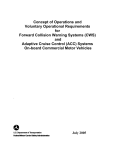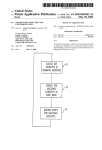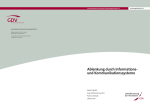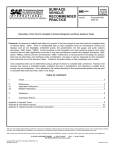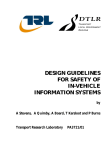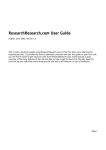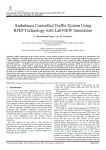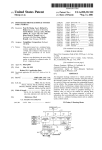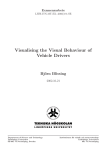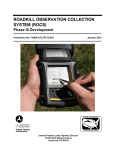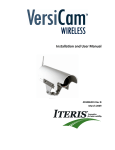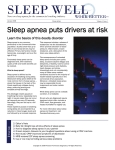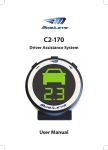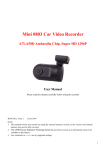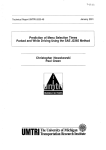Download Concept of Operations and Voluntary Operational Requirements
Transcript
Concept of Operations and Voluntary Operational Requirements for Lane Departure Warning Systems (LDWS) On-board Commercial Motor Vehicles July 2005 Foreword The Federal Motor Carrier Safety Administration’s (FMCSA’s) safety goal is to reduce the number and severity of large truck fatalities and crashes. During the last several years, FMCSA has collaborated with the trucking industry to test and evaluate several on-board safety systems for commercial motor vehicles to increase the safety and security of all roadway users. FMCSA is now promoting voluntary adoption of these systems within trucking fleets by initiating steps to work closely with the trucking industry to define vendor-independent, voluntary requirements. The purpose of this document is to relay a better understanding of the functions of on-board safety systems for vehicle stability and to provide insight into the safety and efficiency benefits of using the systems. This document describes the concept of operations and voluntary requirements for Lane Departure Warning Systems (LDWS) for large trucks greater than 10,000 pounds gross vehicle weight rating (GVWR). Concepts of operations provide information about how each user interacts with these safety systems and their operational conditions. Voluntary requirements describe features and functions used to define the safety systems and their operational functionality. The information has been developed in collaboration with trucking industry stakeholders, including representatives from manufacturers, insurance companies, commercial vehicle carriers, drivers and academia. The results from this project can be used by motor carriers as system guidelines for voluntary adoption of on-board safety systems within their trucking fleets. This is a final report developed under FMCSA’s deployment of on-board safety system program. It does not supersede an earlier report on the subject. Notice This document is disseminated under the sponsorship of the Department of Transportation in the interest of information exchange. The United States Government assumes no liability for its contents or use thereof. This report does not constitute a standard, specification, or regulation. The United States Government does not endorse products or manufacturers. Trade or manufacturers' names appear herein only because they are considered essential to the object of this document. i Acknowledgements FMCSA wishes to acknowledge the efforts of those in the government, academia, research institutions and industry who contributed their knowledge and expertise to this effort. Those individuals include Carl Kirk and Robert Braswell of the Technology and Maintenance Council; Marty Fletcher of US Xpress; Jim Kennedy of McKenzie Tanklines; Ron Knipling, PhD of the Virginia Tech Transportation Institute; Scott Claffey of Great West Insurance Company; Dave Melton of Liberty Mutual Research Institute for Safety; Anne McCartt, PhD of the Insurance Institute for Highway Safety; Rick Craig of the Owner Operators Independent Drivers Association; Bill Gouse of the American Trucking Associations; Tom Moses of the Spill Center; Bob Interbitzen of the National Private Truck Council; Mike Formica and Dean Pomerleau, PhD of Assistware; Bill Patrolia of Iteris; Meny Benady of Mobileye; Kevin Romanchok, Jim Szudy, and Richard Beyer of Bendix; Alan Korn, Richard Romer, and Mike Lambie of Meritor WABCO; Greg Shipman of Delphi; Tom Mattox of Eaton VORAD; Skip Yeakel of Volvo; Charlie Groeller of Mack Trucks; Paul Menig of Freightliner; and Dan Murray of the American Transportation Research Institute. ii Technical Report Documentation Page 1. Report No. 2. Government Accession No. 3. Recipient's Catalog No. FMCSA-MCRR-05-005 4. Title and Subtitle Concept of Operations and Voluntary Operational Requirements for Lane Departure Warning System (LDWS) On-board Commercial Motor Vehicles 5. Report Date July 2005 6. Performing Organization Code 7. Author(s) Amy Houser (FMCSA), John Pierowicz (Calspan Corp.), Dan Fuglewicz (Calspan Corp.) 8. Performing Organization Report No. 9. Performing Organization Name and Address Calspan Corporation 4455 Genesee Street Buffalo, NY 14225 12. Sponsoring Agency Name and Address Federal Motor Carrier Safety Administration Office of Research and Analysis 400 Virginia Ave. SW Washington, DC 20024 10. Work Unit No. (TRAIS) 11. Contract or Grant No. DTMC75-03-F-00087 13. Type of Report and Period Covered Technical Report – October 2003-July 2005 14. Sponsoring Agency Code FMCSA 15. Supplementary Notes This program was administered through the Federal Motor Carrier Safety Administration (FMCSA). The FMCSA Program Manager is Mrs. Amy Houser. 16. Abstract The Federal Motor Carrier Safety Administration’s (FMCSA’s) safety goal is to reduce the number and severity of large truck fatalities and crashes. During the last several years, FMCSA has collaborated with the trucking industry to test and evaluate several on-board safety systems for commercial motor vehicles to increase the safety and security of all roadway users. FMCSA is now promoting voluntary adoption of these systems within trucking fleets by initiating steps to work closely with the trucking industry to define vendor-independent, voluntary requirements. The purpose of this document is to relay a better understanding of the functions of on-board safety systems and to provide insight into the safety and efficiency benefits of using the systems. The information has been developed in collaboration with expert panels consisting of trucking industry stakeholders, including representatives from manufacturers, insurance companies, commercial motor vehicle carriers, drivers, and academia. This document describes the concept of operations and voluntary requirements for Lane Departure Warning Systems (LDWS) for large trucks greater than 10,000 pounds gross vehicle weight rating (GVWR). Concepts of operations provide information about how each user interacts with these safety systems and their operational conditions. Voluntary requirements describe features and functions used to define the safety systems and their operational functionality. 17. Key Word Commercial Motor Vehicles, Heavy Trucks, Lane Departure, Safety Systems, Tractor-Trailers 19. Security Classif. (of this report) Unclassified Form DOT F 1700.7 (8-72) 18. Distribution Statement 20. Security Classif. (of this page) Unclassified Reproduction of completed page authorized iii 21. No. of Pages 22 22. Price SI* (MODERN METRIC) CONVERSION FACTORS Symbol in ft yd mi in2 ft2 yd2 ac mi2 fl oz gal ft3 yd3 oz lb T APPROXIMATE CONVERSIONS TO SI UNITS When You Know Multiply By To Find inches feet yards miles LENGTH 25.4 0.305 0.914 1.61 square inches square feet square yards acres square miles AREA 645.2 0.093 0.836 0.405 2.59 fluid ounces gallons cubic feet cubic yards VOLUME 29.57 3.785 0.028 0.765 ounces pounds short tons (2000 lbs) MASS 28.35 0.454 0.907 °F Fahrenheit temperature fc fl foot-candles foot-Lamberts lbf psi Symbol millimeters meters meters kilometers mm m m km mm m m km square millimeters square meters square meters hectares square kilometers mm2 mm2 m2 m2 m2 ha km2 m2 ha km2 milliliters liters cubic meters cubic meters grams kilograms megagrams TEMPERATURE (exact) 5(F-32)/9 Celsius or (F-32)/1.8 temperature ILLUMINATION 10.76 3.426 Symbol lux candela/m2 FORCE and PRESSURE or STRESS pound-force 4.45 newtons pound-force 6.89 kilopascals per square inch ml l m3 m3 g kg Mg ml l m3 m3 g kg Mg APPROXIMATE CONVERSIONS FROM SI UNITS When You Know Multiply By To Find millimeters meters meters kilometers LENGTH 0.039 3.28 1.09 0.621 inches feet Yards miles in ft yd mi square millimeters square meters square meters hectares square kilometers AREA 0.0016 10.764 1.195 2.47 0.386 square inches square feet square yards acres square miles in2 ft2 yd2 ac mi2 milliliters liters cubic meters cubic meters VOLUME 0.034 0.264 35.71 1.307 fluid ounces gallons cubic feet cubic yards fl oz gal ft3 yd3 grams kilograms megagrams MASS 0.035 2.202 1.103 ounces pounds short tons (2000 lbs) oz lb T °C °C Celsius temperature lx cd/m2 lx cd/m2 lux candela/m2 N N newtons kPa kPa kilopascals * SI is the symbol for the International System of Units. Appropriate rounding should be made to comply with Section 4 of ASTM E380. iv Symbol TEMPERATURE (exact) 1.8 C + 32 ILLUMINATION 0.0929 0.2919 Fahrenheit temperature °F foot-candles foot-Lamberts fc fl FORCE and PRESSURE or STRESS 0.225 pound-force 0.145 pound-force per square inch lbf psi 1. INTRODUCTION The Federal Motor Carrier Safety Administration’s (FMCSA’s) safety goal is to reduce the number and severity of large truck fatalities and crashes. During the last several years, FMCSA has collaborated with the trucking industry to test and evaluate several on-board safety systems for commercial motor vehicles to increase the safety and security of all roadway users. FMCSA is now promoting voluntary adoption of these systems within trucking fleets by initiating steps to work closely with the trucking industry to define vendor-independent, voluntary requirements for these systems. The purpose of this document is to relay a better understanding of the functions of on-board safety systems and to provide insight into the safety and efficiency benefits of using the systems. This information was developed in collaboration with expert panels consisting of trucking industry stakeholders, including representatives from manufacturers, insurance companies, commercial motor vehicle carriers, drivers, and academia. This document describes the concept of operations and voluntary requirements for Lane Departure Warning Systems (LDWS) for large trucks greater than 10,000 pounds gross vehicle weight rating (GVWR). Concepts of operations provide information about how each user interacts with these safety systems and their operational conditions. Voluntary requirements describe features and functions used to define the safety systems and their operational functionality. This document discusses vision-based LDWS provided by manufacturers, such as: • AssistWare Technology • Delphi Electronics and Safety • Iteris • Mobileye NV Appendix A lists the commercial off-the-shelf (COTS) systems that currently exist or will be soon released to the market. United States Department of Transportation (USDOT) websites that contain further information on governmental research, testing and evaluation of LDWS include: www.its.dot.gov/ivi/ivi.htm www.fmcsa.dot.gov/safetyprogs/research/researchpubs.htm 2. CONCEPT OF OPERATIONS Description – Lane Departure Warning Systems LDWS are in-vehicle electronic systems that monitor the position of a vehicle within a roadway lane and warn a driver if the vehicle deviates or is about to deviate outside the lane. Currently available LDWS are forward looking, vision-based systems that use algorithms to interpret video images to estimate vehicle state (lateral position, lateral velocity, heading, etc.) and roadway alignment (lane width, road curvature, etc.). LDWS warn the driver of a lane departure when the vehicle is traveling above a certain speed threshold and the vehicle’s turn signal is not in use. In addition, LDWS notify the driver when lane markings are inadequate for detection, or if the system malfunctions. LDWS do not take any automatic action to avoid a lane departure or to control the vehicle; therefore, drivers remain responsible for the safe operation of their vehicles. When the vehicle is traveling in close proximity to the center of the lane it is with the systems “no warning zone”, the system does not issue any position warnings. As the vehicle deviates from the no warning 1 zone the system calculates the time for the vehicle to exit the lane. The LDWS calculates an earliest and latest warning line. As shown in Figure 1, the “earliest warning line” is inside the lane boundary and the “latest warning line” is outside the lane boundary. The “warning threshold placement zone” is the area between the earliest warning lines and the latest warning lines. Whenever the vehicle crosses out of the no warning zone into the zone between the earliest warning line and latest warning line, the LDWS issues a lane departure warning. Figure 1 illustrates these warning thresholds. Figure 1. LDWS Warning Thresholds and Warning Threshold Placement Zones (For illustration only – not to scale.) Some of these LDWS may be installed directly by the fleets as an aftermarket accessory, while other LDWS are installed by truck Original Equipment Manufacturers (OEMs) when the vehicles are manufactured. As technology advances, new features and components may be added to these systems. Crash Prevention LDWS can help prevent single vehicle roadway departure, lane change/merge, and rollover crashes: • Single vehicle roadway departure – LDWS issue a warning as the truck crosses the shoulder lane marking. Without the system, the truck may be driven off the shoulder and crash into off-road obstacles (e.g., light poles, signs, guardrails, trees, and stopped vehicles) or roll over. Data derived from the 2003 General Estimates System (GES) indicates that 13,000 roadway departure crashes involving large trucks occurred in 2003, resulting in 90 fatalities. 1 • Lane change/merge – LDWS issue a warning as the truck crosses center lane markings on multi-lane roadways, including solid lines, double lines, dotted lines, dashed lines, and raised pavement markers (Bott’s Dots). Without the system, the truck may be 1 The General Estimates System is directed by the National Center for Statistics and Analysis, which is a component of The Office of Research and Development in NHTSA. Data for GES come from a nationally representative sample of police reported motor vehicle crashes of all types, from minor to fatal. The system began operation in 1988, and was created to identify traffic safety problem areas, provide a basis for regulatory and consumer initiatives, and form the basis for cost and benefit analyses of traffic safety initiatives. The information is used to estimate how many motor vehicle crashes of different kinds take place, and what happens when they occur. 2 driven into an adjacent lane, resulting in a head-on or sideswipe collision. • Rollovers – LDWS may also prevent some crashes that would be categorized as rollover crashes. For example, if the vehicle drifts out of the lane onto the shoulder, the truck could roll over if a sudden recovery maneuver is made. A truck may also roll over due to any recovery maneuver involving a high lateral velocity (rate of departure), requiring a relative large amplitude and/or rapid steering action. LDWS may also: • Assist the driver in consistently keeping a vehicle in the lane, thereby reducing lanedeparture crashes. • Encourage the driver to use turn signals when changing lanes (otherwise, a lanedeparture warning sounds). • Reinforce driver awareness of vehicle position in the lane to maintain a more central lane position and improve the driver’s attentiveness to the driving task. LDWS cannot prevent all single vehicle roadway departure crashes. These are warning devices and do not actively prevent crashes–they warn the driver so he/she can maneuver the truck to prevent a crash. For example, crashes involving vehicle loss of control due to slippery roads and excessive speed on turns would not be prevented with these systems. Also, the systems will not prevent crashes due to intentional lane changes, which involve the driver’s failure to see another vehicle in the adjacent lane. These crashes can be caused by a driver’s failure to look or by an adjacent vehicle being in a blind spot. (Some collision warning systems (CWS) have blind spot sensors to help prevent these types of crashes.) Yet, the use of LDWS provides immediate warnings to drivers regarding unintentional lane departure events, which may improve driving performance over time. Operations and Users This section describes how drivers, fleet managers, and fleet maintenance personnel interact with LDWS and potential benefits that each stakeholder may realize with these systems. The commercial vehicle population is comprised of a wide variety of vehicle types and uses. At a high level, two types of vehicles are predominant, combination vehicles (tractors-trailers) and straight trucks. These two types of vehicles have very different operating characteristics. In general, straight trucks tend to be used in a more local setting and provide deliveries of goods and services to customers generally within a 50 to 100 mile radius of their base of operations. Combination vehicles are more often utilized in regional and long distance applications, and account for about 30% of total commercial vehicles, but 65% of the commercial vehicle miles traveled. Due to their high mileage exposure and severity of crashes, combination-unit trucks have the highest crash cost per vehicle over the operational life of the vehicle. 2 The trucking industry is actually a broad collection of many industries, each with operating characteristics as diverse as the industries they service. Segmentation of the trucking industry is often based on the size of fleets, the geographic range of its operations and the commodities hauled. Usually one characteristic is not adequate to describe a particular segment, but rather combinations of characteristics are required to best describe operations. For example, there may be a trucking firm with a large fleet providing package delivery type service to a relatively small geographic area, while there may be a single truck company that provides general freight 2 Wang, J.S.; Knipling, R.R.; and Blincoe, L.J. The Dimensions of Motor Vehicle Crash Risk. Journal of Transportation and Statistics. Volume 2, No. 1, pp. 19-43, ISSN 1094-8848, May 1999. 3 services to all states in the continental United States. The movement of goods by truck is conducted on all types of roads, at all hours of the day, and in all types of driving conditions. Since unintentional lane departures can occur along any route, many fleet types may benefit from using LDWS. Yet, they may be most promising for trucks with high mileage accumulated over their operational life or that operate under conditions that may present driving challenges such as nighttime, limited visibility due to weather, congestion, or roadways of geometry or configuration that can be difficult to negotiate. Drivers Drivers are the primary LDWS users, as described in the following daily operational scenarios: Normal system startup operation – When the driver turns the ignition switch to start the vehicle, the LDWS performs a power-up self-test, and the driver scans the warning indicator to determine any system malfunctions. If necessary, the driver may alert fleet maintenance for corrective action. When the vehicle reaches the minimum LDWS tracking speed on a roadway with lane boundary markings, lane tracking begins. The driver can scan the LDWS tracking indicator to verify that lane tracking has commenced. Warning/alert situations – When traveling at or above the minimum LDWS tracking speed, a driver may unintentionally drift out of the lane. Then, the LDWS issues a warning at the LDWS warning threshold. System fault conditions – When the LDWS cannot track the lane or a system fault occurs, the driver is notified via the lane-tracking indicator. This inability to track lanes may be due to a lack of lane markings, poor quality of lane markings, poor visibility, or a dirty/icy windshield. Although LDWS cameras typically view the road through a portion of the windshield swept by the wipers, the driver can manually clean the windshield area in front of the LDWS camera to see if the LDWS begins to track. Some LDWS may display various messages when certain types of faults or other conditions are detected, such as “Calibration in Progress”. Various road types and conditions – A driver may encounter several types of roads and conditions where these systems perform optimally, but some conditions limited the devices, especially when lane markings cannot be well-detected. Well-Marked Roads – The most commonly encountered roadway markings include single and double solid lines, dashed and dotted lines, and raised pavement markers (Bott’s dots) where LDWS should detect lane departures and issue warnings to a driver traveling over the minimum tracking speed. Roads With Missing or Degraded Lane Boundary Markers – If lanes have missing or degraded lane markings, the driver may not receive a warning as the vehicle progresses outside of the lane, depending on the particular LDWS used. On roads with only one set of markers, the driver should receive a warning when the warning threshold is crossed on that side, even if the system cannot detect the lane boundary on the other side. Delivery Points, Arterials, and Collectors – Currently available LDWS will not operate at delivery points and roads where the truck travels at speeds below the minimum LDWS tracking speed. Currently available LDWS are geared primarily for highway driving and will not function at lower speeds associated with some local roads. As a result, the LDWS would notify drivers that the system is operational, but it is not providing warnings under these conditions. 4 Wet Roads – Due to reflections on wet road surfaces, LDWS may occasionally be unable to detect lane markings; however, the lane-tracking indicator will show that the system is not providing warnings under these conditions. Mud-/Ice-/Snow-Covered Roads – When lane markings are not visible on roads covered by mud, ice, or snow, the lane tracking indicator will show that the system is inactive. LDWS may be beneficial in low visibility conditions (e.g., rain, fog, and falling snow) when lane markings are present. Fleet Management Fleet managers are responsible for all administrative, financial, and operational aspects of the fleet. Safety officers focus on the fleet’s operational safety issues and examine the safety aspects of the fleet’s vehicles in accordance with USDOT safety regulations. They also work with drivers to provide safety and operational training, verify that drivers are complying with safety regulations, and examine how well drivers operate their vehicles (e.g., logging accidents, traffic infractions, etc.). These personnel examine various types of available safety equipment, evaluate the equipment, justify the purchase of all equipment, determine the overall effectiveness of this equipment, and calculate the return on investment (ROI) for their fleet. They work with the maintenance department and drivers to explain LDWS benefits. Fleet managers may obtain operational data (e.g., number of lane departures) from LDWS via the in-vehicle network, and analyze the data to determine any systemic problems with their fleet operations (e.g., disproportionate number of lane departures with certain drivers, high number of lane departures on certain routes) and to use for driver training. Research has indicated that the monitoring of driver behavior may have a positive effect on driver and fleet safety. 3 In the Fatigue Management Technology Pilot Test, drivers’ opinions were positive towards the use of the LDWS deployed in this test, and the results of this specific test showed that drivers prefer vehicle monitoring versus driver monitoring as a means of driver feedback. 4 Maintenance Management and Installation Maintenance managers and service technicians are responsible for the proper functioning of all equipment installed on the fleet’s vehicles and for installing and maintaining LDWS on the fleet. They support fleet management by collecting operational data on the reliability of LDWS and how well LDWS suppliers work with the fleet to resolve any problems if LDWS are not supplied directly by the truck OEMs. LDWS have different installation requirements for each vehicle type. Depending on the system, LDWS may be installed by a truck OEM or as an aftermarket accessory by the fleet or other service personnel. When the currently available vision based LDWS is installed by a truck OEM, the LDWS camera location and mounting bracket attachment method are similar for each vehicle type. The OEM provides dedicated wiring harnesses for the connection between the LDWS and the vehicle. If 3 Knipling, R.R.; Boyle, L.N.; Hickman, J.S.; York, J.S.; Daecher, C., Olson, E.C.B., and Prailey, T.D. Synthesis Report # 4: Individual Differences and the High-Risk Commercial Driver. Project Final Report, Transportation Research Board Commercial Truck and Bus Synthesis Program. ISSN 1544-6808, ISSN 0-309-08810-0, available at http://trb.org/news/blurb_browse.asp?id=11, 2004. 4 Dinges, David F.; Maislin, Greg; Brewster, Rebecca; Krueger, Gerald P.; and Carroll, Robert, J. “Pilot Test of Fatigue Management Technologies”, Paper No. 05-1234, TRB 2005 Annual Meeting. 5 necessary, the OEM enters system settings, such as the height of the camera from the ground, and the position of camera relative to the middle of the windshield, to configure the system for proper operation. When the currently available vision based LDWS is installed as an aftermarket accessory, the LDWS camera must be properly oriented, pointing directly toward the middle of the lane and angled slightly downward, as described in the user’s manual. Then, key parameters are entered into the system, including the height of the camera from the ground and the position of the camera relative to the middle of the vehicle. 3. VOLUNTARY REQUIREMENTS The voluntary requirements included in the following sections define fundamental LDWS features and the ability of LDWS to withstand the electrical and environmental extremes commonly found on commercial vehicles. The types of voluntary requirements for LDWS include: 1. Functional Requirements 2. Data Requirements 3. Hardware and Software Requirements 4. Driver Vehicle Interface (DVI) Requirements 5. Maintenance and Support Requirements LDWS manufacturers may include additional functions and features that may be useful beyond minimum LDWS functionality; the operational features that fall into this category are labeled with the term “OPTIONAL”. However, in all cases, LDWS must comply with all existing FMCSA Safety Regulations. The requirement numbering system designates optional features with a “T” and system defining requirements with an “R”. 3.1 Functional Requirements Functional requirements refer to the basic functionality and operation of LDWS. R1-1 LDWS should perform a self-test that checks all major system sensors and components, operate within 30 seconds of starting the vehicle, and relay the results of the self-test to the driver indicating whether the system is operational. R1-2 LDWS should detect vehicle position relative to following types of visible lane boundaries: • Solid and dashed painted lines • Single and double painted lines • Yellow and white painted lines • Raised pavement markers (Bott’s dots) • Lines with and without reflectors/reflective material R1-3 LDWS should issue warnings, detect vehicle position relative to visible lane boundaries, and track lane boundaries when the vehicle is traveling at or above a speed of 60 kilometers per hour (kph) (37 miles per hour (mph)). R1-4 LDWS should issue warnings, detect vehicle position relative to visible lane boundaries, and track lane boundaries where lane markings are clearly visible in daylight (sunny/cloudy), nighttime (with and without streetlight 6 illumination), and twilight (sunrise/sunset) lighting conditions. R1-5 LDWS should use warning thresholds to determine when the vehicle departs a lane, or is about to leave the lane. At least one warning threshold should be established for each side of the lane and should be optimized for the specific type of commercial motor vehicle, such that nuisance alarms are minimized and threshold warnings are given in time for the driver to make a correction. R1-6 LDWS should be able to track lane boundaries and issue warnings within ±0.1 meter (±4 inches) from the warning thresholds when the vehicle’s rate of lane departure is < 0.8 m/s (2.6 ft./s). 5 R1-7 LDWS should be able to track the lane boundary that the vehicle is heading towards 95% of the time on dry straight roads when lane boundary markings of the types listed in R1-2 are present. R1-8 LDWS should be able to issue lane departure warnings 95% of the time, for both left and right lane departures, on dry straight roads when lane boundary markings of the types listed in R1-2 are present. R1-9 LDWS should issue lane departure warnings on straight roadways as described in R1-8. LDWS should also issue warnings when at least one of the roadway curvature test conditions listed in Table 1 is encountered. 6 Table 1 LDWS Warning Curved Roadway Test Conditions Condition Road Curvature Radius Operating Speed 1 (metric units) ≥ 250 m < 72 kph, ≥ 61 kph 1 (English units) ≥ 820 feet < 45 mph, ≥ 38 mph 2 (metric units) ≥ 500 m ≥ 72 kph 2 (English units) ≥ 1640 feet ≥ 45 mph R1-10 LDWS should not issue warnings for lane departures when the driver uses the vehicle’s turn signal in the intended direction of the lane change. R1-11 LDWS should function properly when the windshield wipers are operating. T1-1 OPTIONAL – LDWS may issue directional warnings to alert the driver to which side of the lane the vehicle is drifting. A directional warning may be audible, such as rumble strip sounds in left or right in-cab speakers, or tactile. T1-2 OPTIONAL – When driving along a curve, LDWS may move the warning threshold farther out, allowing “curve cutting” behavior. However, the warning threshold should not be placed beyond the latest warning line. Curve cutting is the act of driving to the inside of a curved section of roadway or taking a small shortcut across the curve. 5 International Standard: ISO/CD17361 5.2. Intelligent Transport Systems - Lane Departure Warning Systems Performance Requirements and Test Procedures. June 23, 2003. 6 International Standard: ISO/CD17361 5.2. Intelligent Transport Systems - Lane Departure Warning Systems Performance Requirements and Test Procedures. June 23, 2003. 7 T1-3 OPTIONAL – LDWS may provide a warning based on the analysis of Time to Lane Crossing (TLC). In this mode, the warning is issued prior to the actual crossing of the warning line. Lateral vehicle motion may be analyzed to calculate the TLC value. T1-4 OPTIONAL – LDWS may provide a differential warning based on the type of lane boundary (e.g., solid or dashed). The difference may be observed in the volume or length of the alert. T1-5 OPTIONAL – LDWS may provide a warning upon crossing a road edge in absence of lane markings, or suppress it. T1-7 OPTIONAL – LDWS may report system fault conditions on construction areas where multiple or conflicting lane boundaries exist. T1-8 OPTIONAL – LDWS may issue warnings when turn signals are left on for more than a pre-specified threshold period. 3.2 Data Requirements This section defines the format of data generated by or can be obtained directly in real-time from LDWS. Two Society of Automotive Engineers (SAE) standards specify in-vehicle data communication in heavy trucks: • SAE J1587, “Electronic Data Interchange between Microcomputer Systems in HeavyDuty Vehicle Applications” (message definition for the J1708 data bus), or • SAE J1939-71, “Recommended Practice for Control and Communications Network for On-Highway Equipment – Vehicle Application Layer” The data may be obtained via the On-Board Diagnostic (OBD) connector from one of the invehicle data networks, J1708 or J1939, as defined by their respective Society of Automotive Engineers (SAE) standards. T2-1 OPTIONAL – LDWS may have the capability to store operational data for providing driving feedback to drivers. 3.3 Hardware and Software Requirements Hardware and software requirements deal directly with the detailed functionality of the hardware, environmental and electrical concerns, mounting/installation issues, and software design. Figure 2 illustrates the major functional components and interfaces of LDWS, as described in the following section. It shows the inter-relationship of the LDWS components. The electronic control unit (ECU) accepts data from the lane boundary sensor. Through the vehicle network (J1708 or J1939), the ECU monitors the turn signal status and engine power. The output of the system is a status indicator and, when necessary, a warning, which appear on the driver-vehicle interface. 8 Figure 2 LDWS Major Functional Components Typical System Hardware This section describes the functionality of the primary physical components of LDWS. They refer to the functional blocks shown in Figure 2. R3-1 Lane Boundary Sensor – A lane boundary sensor should detect vehicle position relative to visible lane boundaries and track lane boundaries. If the detector is a vision-based system, the image of lane boundaries may be black and white or color and may be transferred in either digital or video format. R3-2 Electronic Control Unit (ECU) – The LDWS ECU should process data from lane boundary sensors to establish whether the vehicle is within the no warning zone or has crossed a warning threshold. The LDWS ECU should detect when the vehicle drifts toward an unintended (no active turn signal) lane change and automatically emit a warning for the driver to make a correction. R3-3 Driver Vehicle Interface – LDWS should provide a Driver Vehicle Interface (DVI) for the driver to interact with the system. The LDWS DVI consists of controls, indicator lights, and audio sources used by the driver for LDWS operation. The LDWS DVI may include an alphanumeric or graphical display. See Section 3.4 for additional DVI requirements. R3-4 Turn Signal Status – LDWS should monitor the turn signal’s status and issue lane departure warnings only when the driver does not use the vehicle’s turn signal in the intended direction of the lane change. R3-5 Vehicle Power – Vehicle power should provide power to LDWS. R3-6 Driver Warning – LDWS should provide a warning to the driver when the vehicle drifts out of the lane or is about to leave the lane. This warning can be audible, visual, or tactile. R3-7 Visual Status Indication – LDWS should self-diagnose a failure and provide a visual indication to alert the driver of the system status, which includes operational/non-operational, tracking/not-tracking, and system fault conditions. T3-1 OPTIONAL – Vehicle Network – LDWS may use the in-vehicle data network 9 (SAE J1708 or J1939) for data communication to data recording or diagnostic devices. Environmental Requirements The SAE has developed a comprehensive standard that describes various aspects of the heavy truck environment in its J1455 standard, which includes procedures to verify system compliance. R3-8 LDWS should meet the environmental requirements as stated in the most recent version of the following SAE standard: SAE Standard J1455, “Joint SAE/ Technology and Maintenance Council (TMC) Recommended Environmental Practices for Electronic Equipment Design (Heavy-Duty Trucks)”. The following environmental aspects are covered by the standard: • • • • • • • • • • Altitude Fungus Mechanical Shock Mechanical Vibration Relative Humidity Temperature Salt Spray Atmosphere Immersion and Splash Steam Cleaning and Pressure Washing Dust, Sand, and Gravel Bombardment Electrical Requirements In a truck’s electrical power distribution system, the system voltage may vary, electrical noise may be generated by the alternator, and various types of transients may momentarily place over 100 volts direct current (VDC) on the electrical distribution system’s wiring. In addition, electrostatic discharge into the system may occur from a buildup of static electricity. Since LDWS may be connected to the electrical power distribution system, they should function normally throughout all of these perturbations without damage. R3-9 LDWS should meet the electrical requirements as stated in most recent version of the following SAE standards: SAE Standard J1455, “Joint SAE/TMC Recommended Environmental Practices for Electronic Equipment Design (Heavy-Duty Trucks)”. SAE Standard J1113, “Electromagnetic Compatibility Measurement Procedures and Limits for Vehicle Components (Except Aircraft) (60 Hz to 18 GHz)”. The following environmental aspects are covered by the standards: • Steady State Electrical Characteristics • Transient Electrical Characteristics • Electromagnetic Susceptibility • Electromagnetic Emission R3-10 LDWS data should not be destroyed nor corrupted during a power surge. Mounting and Installation Requirements Mounting and installation requirements include all aspects related to the installation of LDWS hardware onto the vehicle. There are no specific requirements pertaining to system size or 10 weight. R3-11 If sensors, such as vision-based LDWS cameras are mounted in the swept area of the windshield, they should be small enough to preclude obstructing a driver’s vision. R3-12 LDWS sensor mounting should isolate sensors, such as vision-based LDWS cameras, from mounting surface vibrations. R3-13 All LDWS cables, connectors, and components should be rated for automotive duty as defined by the SAE and be appropriate for their operational environment (e.g., LDWS components mounted on the exterior of the vehicle should be rated for exterior duty). R3-14 Major LDWS components, other than cabling or small mounting components, should be marked with the manufacturer’s identification. Software Requirements Software requirements refer to the embedded software that runs in LDWS and controls all LDWS functionality. The microcontroller or microprocessor continuously runs LDWS software when the system is active. T3-2 OPTIONAL – LDWS may include software for downloading ASCII data files that can be easily read into a statistical, database, or spreadsheet software package. T3-3 OPTIONAL – The embedded software of LDWS may be field upgradeable via the in-vehicle network connection (i.e., J1587 or J1939) or other common data interface (e.g., RS-232 or USB). 3.4 Driver Vehicle Interface Requirements These requirements define LDWS interface with the driver, which includes indicators, displays, and warning methods. The National Highway Traffic Safety Administration (NHTSA) Federal Motor Vehicle Safety Standard 101 (FMVSS 101) should be used as a guide for LDWS indicators. R4-1 LDWS should issue an audible or tactile warning when the vehicle crosses the warning threshold. R4-2 LDWS should include a visual indicator to indicate when the system is not tracking the vehicle’s position in the lane. This status may be indicated by an instrument panel warning light or an indicator that is integral to LDWS. R4-3 LDWS should use a visual indicator to indicate that the system is operational and ready to function. This status may be indicated by an instrument panel warning light or an indicator that is integral to LDWS. R4-4 LDWS should use a visual or audible indicator to indicate a system failure or malfunction. This status may be indicated by an instrument panel warning light or an indicator that is integral to LDWS. R4-5 LDWS indicators should be clearly discernable in direct sunlight and at night. T4-1 OPTIONAL – LDWS may graphically indicate on a user interface display the vehicle’s position relative to both lane boundaries, and to which side of the lane a departure occurs. 11 T4-2 OPTIONAL – LDWS may graphically indicate on a user interface display when lane tracking is not being performed, and may indicate which side is or is not tracking. T4-3 OPTIONAL – LDWS may provide a directional or non-directional tactile warning (e.g., rumble seat) to indicate a lane departure in the left or right direction. T4-4 OPTIONAL – LDWS may allow the volume of the audible warnings to be adjusted, but not below a minimum sound level of 65 dBA. 7 T4-5 OPTIONAL – LDWS may graphically indicate on a user interface display how well the vehicle is centered in the lane on a time-averaged basis. T4-6 OPTIONAL – LDWS may provide operational or diagnostic messages or codes such as “System Operational”, “Lane Tracking Active”, or “Clean Windshield” on an alphanumeric display to alert the driver of specific faults, conditions, or concerns. 3.5 Maintenance and Support Requirements Maintenance and support requirements include functionality/features that should be provided to ensure LDWS will be operated correctly and properly maintained. R5-1 The only driver maintenance LDWS should require is maintaining a clean windshield and camera lens for vision-based LDWS. R5-2 LDWS should automatically maintain calibration on a particular vehicle to compensate for normal or expected changes in vehicle loading (e.g., full/empty gas tank, truck with/without trailers, with/without cargo, and one or more passengers). R5-3 An operator’s manual or other document should supply a user procedure to verify that LDWS are calibrated and functional. R5-4 Users should be provided with a manual and training for LDWS. All application software programs should include installation instructions and user manuals. R5-5 At a minimum, the user’s manual should include information on the minimum vehicle speed at which LDWS operate, the types of markings LDWS can track, and the types of indicators used to inform drivers LDWS are functioning properly and tracking the lane. T5-1 OPTIONAL – Video, audio, or computer-based training material may be provided for fleet management and/or drivers. T5-2 OPTIONAL - LDWS may be transferable from one vehicle to another. Forced recalibration and/or resetting of system parameters may be necessary when LDWS are transferred between vehicles. 7 For reference: 90 dBA = heavy truck at 10m, 80 dBA = curbside of busy street, 70 dBA = car interior, 60 dBA = normal conversation at 1m (3.28 ft.), and 50 dBA = office noise. 12 4. ACRONYMS Acronym ASCII Definition American Standard Code for Information Exchange COTS Commercial Off-The-Shelf CWS Collision Warning Systems DVI Driver-Vehicle Interface ECU Electronic Control Unit FMCSA Federal Motor Carrier Safety Administration FMVSS Federal Motor Vehicle Safety Standard FOT Field Operational Test GES General Estimates System GVWR Gross Vehicle Weight Rating HMI Human Machine Interface ISO International Standards Organization kph Kilometers per Hour LDTS Lane Detection and Tracking Subsystem LDW Lane Departure Warning LDWS Lane Departure Warning System(s) L/SH Local/Short-Haul LH Long-Haul LED Light Emitting Diode mph Miles per Hour NHTSA National Highway Traffic Safety Administration OBD On-Board Diagnostic OEM Original Equipment Manufacturer ROI Return on Investment SAE Society of Automotive Engineers TLC Time to Lane Crossing TMC Technology and Maintenance Council USB Universal Serial Bus USDOT United States Department of Transportation VDC Volts Direct Current 13 5. REFERENCES Dinges, David F.; Maislin, Greg; Brewster, Rebecca; Krueger, Gerald P.; and Carroll, Robert, J. “Pilot Test of Fatigue Management Technologies”, Paper No. 05-1234, TRB 2005 Annual Meeting. Draft International Standards Organization (ISO) Standard ISO/CD17361, “Intelligent Transport Systems, Lane Departure Warning Systems – Performance Requirements and Test Procedures”, June 23, 2003. Insurance Institute for Highway Safety, “Request for Comments on Proposal for Pilot Program, Younger Commercial Driver Pilot Training Program”, Docket No. FMCSA-20008410, May 21, 2001. SAE Standard J1113, “Electromagnetic Compatibility Measurement Procedures and Limits for Vehicle Components (Except Aircraft) (60 Hz to 18 GHz)”, July 1995. SAE Standard J1455, “Joint SAE/TMC Recommended Environmental Practices for Electronic Equipment Design (Heavy-Duty Trucks)”, August 1994. SAE Standard J1587, “Electronic Data Interchange between Microcomputer Systems in Heavy-Duty Vehicle Applications”, February 2002. SAE Standard J1708, “Serial Data Communications between Microcomputer Systems”, October 1993. SAE Standard J1939-71, “Recommended Practice for Control and Communications Network for On-Highway Equipment – Vehicle Application Layer”, September 2002. Wang, J.S.; Knipling, R.R.; and Blincoe, L.J. The Dimensions of Motor Vehicle Crash Risk. Journal of Transportation and Statistics. Volume 2, No. 1, pp. 19-43, ISSN 1094-8848, May 1999. Wierwille, W.W.; Lewin, M.G.; and Fairbanks, R.J. III. Final Report: Research on VehicleBased Driver Status/Performance Monitoring; Part I. Vehicle Analysis and Simulation Laboratory, Virginia Polytechnic Institute and State University, Publication No. DOT HS 808 638, September 1996. Wierwille, W.W.; Lewin, M.G.; and Fairbanks, R.J. III. Final Report: Research on VehicleBased Driver Status/Performance Monitoring; Part II. Vehicle Analysis and Simulation Laboratory, Virginia Polytechnic Institute and State University, Publication No. DOT HS 808 638, September 1996. Wierwille, W.W.; Lewin, M.G.; and Fairbanks, R.J. III. Final Report: Research on VehicleBased Driver Status/Performance Monitoring; Part III. Vehicle Analysis and Simulation Laboratory, Virginia Polytechnic Institute and State University, Publication No. DOT HS 808 638, September 1996. 14 A. APPENDIX A – COMMERCIAL OFF-THE-SHELF LDWS The following Commercial Off-the-Shelf (COTS) LDWS are currently available: AssistWare Technology (www.assistware.com) – The “SafeTRAC Drowsy Driver Warning System” includes a digital camera and an image processing/user display unit. The user display contains an alphanumeric/graphical display to indicate vehicle position in the lane and to provide an alertness measure that indicates a driver’s consistency in maintaining a vehicle’s position within the lane. The system includes an audible lane departure warning and ability to control vibrating (haptic) seats as an auxiliary warning device. The system’s warning thresholds and warning volume are adjustable. The system detects visual lane markings and can estimate some lane boundaries when visual lane markings are not present. The system is available as either a factory-installed or an aftermarket system. Delphi Electronics and Safety (www.delphi.com) – The “Delphi Lane Departure Warning System” can be installed by Original Equipment Manufacturers (OEMs) or aftermarket consumers on passenger cars and large commercial vehicles. The Delphi LDWS includes a forward-looking camera, image-processing unit, and human machine interface (HMI), such as a graphical driver display. Functionally, the system is a combination of three distinct parts. The Lane Detection and Tracking Subsystem (LDTS) detects and tracks the lane boundaries. Results of this process are passed to the Warning Subsystem, which determines if and when a lane departure warning should be issued. Warning requests are sent to the HMI Subsystem, which provides the alerts to the driver. The system has a visual directional warning and an audible alert signal whose particular sound can be customized for OEMs. The system also has the ability to control tactile warnings. The warning threshold can be calibrated (i.e., customized) to satisfy a fleet company's requirement. The system is now in development. It is expected to be released Q3 2005. Iteris (www.iteris.com) – The “Auto Vue™ Lane Guidance, Lane Departure Warning System” includes a digital camera and an image processing unit. A green light emitting diode (LED) indicates system status; a yellow LED indicates whether the system is tracking the lane. The system has a directional audible lane departure warning and the ability to control haptic seats as an auxiliary warning device. The warning thresholds are not adjustable. The system, which is available for light vehicles and heavy trucks, is typically installed by a vehicle manufacturer and calibrated at the factory for each vehicle model, but can also be installed as an aftermarket system. Mobileye (www.mobileye.com) – The “Mobileye Lane Departure Warning (LDW) System” includes a camera and a processing unit mounted to the center of the windshield and a cell phone-sized alphanumeric/graphic driver display on the dashboard. Two in-cab speakers, one on either side of the vehicle, provide audible directional warnings. The warning volume is adjustable. The system detects visual lane markings and estimates lane boundaries when visual lane markings are not present. The system predicts the time and provides an early warning of lane crossing by measuring lateral vehicle motion. The system can be installed as an aftermarket system, stand-alone, or as an additional feature with headway monitoring. 15 Summary of COTS System Features Table A-1 provides comparative information relative to the features of each of the COTS systems described in this appendix. Each manufacturer provided this information. Table A-1 Summary of COTS LDWS Features Feature AssistWare Delphi Iteris Mobileye Detects lane boundaries based on lane markers Yes Yes Yes Yes Estimates boundaries when markers not present/visible Yes Limited No Yes Audible lane departure warning Yes Yes Yes Yes Supports tactile (vibratory) lane departure warnings Yes Yes Yes No Lane tracking indicator Yes Yes Yes Yes System status indicator Yes Yes Yes Yes Aftermarket installation by fleets possible Yes Yes Yes Yes Currently sold as aftermarket product Yes No Yes Yes Currently installed by OEMs Yes No Yes No Fleet adjustable warning thresholds Yes Yes No Yes Factory adjustable warning thresholds Yes Yes Yes Yes Alphanumeric/graphical display Yes Yes No Yes Displayed driver alertness measure Yes No No No Directional warnings No Visual Audible Audible & Visual RS-232 or J-1587 J-1587 J-1939 Ethernet or USB 2.0 Data link protocol 16 Report No. FMCSA-MCRR-05-005 For more information on the Federal Motor Carrier Safety Administration and the Office of Research and Analysis, check out our website at www.fmcsa.dot.gov






















